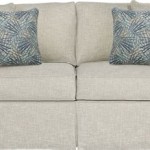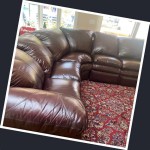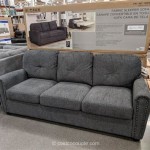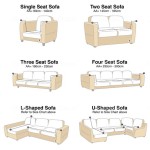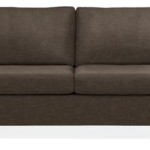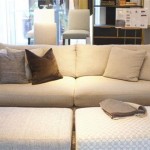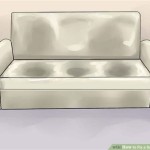The Ergonomics and Psychology of Sitting On A Sofa
The act of sitting on a sofa, a seemingly simple and ubiquitous activity, is a multifaceted experience intertwined with considerations of ergonomics, psychology, and social interaction. Understanding these elements can provide insights into how sofa design and usage can influence physical comfort, mental well-being, and the dynamics of shared spaces.
Sofas have evolved from rudimentary benches to complex pieces of furniture designed for relaxation and social engagement. Their purpose transcends mere seating; they often serve as focal points within living rooms, dens, and common areas. The design and construction of a sofa, therefore, significantly impact the overall functionality and aesthetic appeal of a space.
Ergonomic Considerations for Optimal Comfort
Ergonomics, the science of designing workplaces and equipment to fit the human body, plays a crucial role in sofa design. An ergonomically sound sofa can promote good posture, reduce strain on the musculoskeletal system, and contribute to overall comfort. Conversely, a poorly designed sofa can lead to discomfort, pain, and potentially long-term health issues.
Seat height is a primary ergonomic consideration. The ideal seat height allows the user to place their feet flat on the floor with their knees bent at a 90-degree angle. This position promotes proper spinal alignment and reduces pressure on the lower back. If the seat is too high, the feet dangle, creating pressure behind the knees. If it is too low, the knees are forced higher than the hips, which can strain the lower back and hips.
Seat depth is another critical factor. A seat that is too deep can force the user to slouch or use additional cushions to provide lumbar support. A seat that is too shallow may not provide adequate thigh support, leading to discomfort. The ideal seat depth allows for comfortable seating with the back resting against the back cushion without excessive forward leaning.
Back support is essential for maintaining good posture. Sofas should provide adequate lumbar support, either through the design of the back cushion or the inclusion of separate lumbar cushions. Proper lumbar support helps maintain the natural curvature of the spine, reducing strain and preventing pain. The angle of the backrest also plays a role, with a slight recline generally considered more comfortable than a perfectly upright position.
Armrests contribute to shoulder and neck comfort. The height and width of the armrests should allow the user to rest their arms comfortably without hunching their shoulders or straining their neck. Armrests that are too high can force the shoulders upwards, while those that are too low may not provide adequate support. Similarly, the material and padding of the armrests influence comfort levels.
The materials used in sofa construction also have a significant impact on ergonomics. The density of the foam or filling used in the seat and back cushions determines the level of support and comfort. High-density foam typically provides better support and durability than low-density foam. Upholstery materials, such as fabric or leather, should be breathable and comfortable against the skin. The frame of the sofa should be sturdy and well-constructed to provide a stable and supportive base.
Psychological and Social Aspects of Sofa Placement and Use
Beyond ergonomics, the act of sitting on a sofa is deeply intertwined with psychological and social considerations. Sofas often serve as gathering places for families and friends, fostering social interaction and creating a sense of community. The placement and design of a sofa can significantly influence these dynamics.
The orientation of a sofa within a room can affect the flow of conversation and interaction. For example, a sofa placed facing a television may encourage passive entertainment, while a sofa placed facing other seating arrangements may promote more active social engagement. The arrangement of multiple sofas or chairs in a conversational grouping can create a more intimate and inviting atmosphere.
The size and style of a sofa can also influence its perceived comfort and appeal. Larger sofas may be seen as more inviting and comfortable, particularly for lounging or relaxing. The style of the sofa, whether modern, traditional, or eclectic, can reflect the personality and preferences of the homeowner and contribute to the overall aesthetic of the room.
Color psychology also plays a role in how a sofa is perceived. Warm colors, such as reds and yellows, can create a sense of energy and excitement, while cool colors, such as blues and greens, can be calming and relaxing. Neutral colors, such as beige and gray, can provide a versatile backdrop for other design elements and can be easily adapted to different styles.
The presence of accessories, such as throw pillows and blankets, can enhance the comfort and appeal of a sofa. Throw pillows can provide additional support and cushioning, while blankets can add warmth and texture. The choice of colors, patterns, and textures for these accessories can further personalize the sofa and contribute to the overall aesthetic of the room. Furthermore, the arrangement and styling of these accessories can influence the perceived cleanliness and organizedness of the space.
The sofa often serves as a symbolic representation of comfort, relaxation, and social connection. It is a place where people can unwind after a long day, spend time with loved ones, or simply enjoy a moment of peace and quiet. The psychological association with these positive experiences contributes to the overall appeal of sitting on a sofa.
Impact of Technology and Changing Lifestyles
The advent of technology and evolving lifestyles have also impacted the design and use of sofas. The increasing prevalence of remote work, streaming services, and mobile devices has led to a greater emphasis on comfort and functionality in sofa design.
Many modern sofas are equipped with features such as built-in charging ports, adjustable headrests, and reclining mechanisms to accommodate the needs of technology-driven lifestyles. These features allow users to comfortably work, play, or relax while using their devices. The integration of technology into sofa design reflects the increasing blurring of the lines between work and leisure.
The rise of streaming services and the popularity of binge-watching have also influenced sofa design. Many sofas are now designed with extra-deep seats and plush cushioning to provide optimal comfort for extended periods of lounging. The focus on comfort and relaxation reflects the growing trend of using sofas as entertainment hubs within the home.
Changing lifestyles have also led to a greater demand for modular sofas, which can be easily reconfigured to adapt to different spaces and needs. Modular sofas offer flexibility and versatility, allowing users to create custom seating arrangements that suit their specific preferences. This adaptability is particularly appealing to those living in smaller spaces or those who frequently entertain guests.
Sustainability is another growing consideration in sofa design. Consumers are increasingly seeking out sofas made from eco-friendly materials, such as recycled fabrics and sustainably sourced wood. The demand for sustainable sofas reflects a growing awareness of environmental issues and a desire to make more responsible purchasing decisions. Sofa manufacturers are responding by developing innovative materials and manufacturing processes that minimize environmental impact.
The act of sitting on a sofa, therefore, is not merely a physical activity but a complex interplay of ergonomic, psychological, and social factors. The careful consideration of these elements can lead to the design and selection of sofas that promote comfort, well-being, and positive social interactions. As technology continues to evolve and lifestyles continue to change, the design and use of sofas will undoubtedly continue to adapt and evolve as well.

How To Sit On A Sofa Prevent Back Pain Guide Swyft

Foto De Tired Woman Sitting On Sofa With Crossed Legs Do Stock Adobe

Página 2 Fotos Sitting Sofa 66 000 De Arquivo Grátis Alta Qualidade

Woman Sitting Sofa Imagens Grátis No Freepik

Foto De Bored Man Watching Tv And Sitting On Sofa In The Living Room Do Stock Adobe

9 Best Couches For Posture And Back Health

Foto Homem Sentado No Sofá Marrom Imagem De Pessoa Grátis Unsplash

Sitting On The Couch For This Long Is Bad You Says Mayo Clinic

Man Wearing Suit Sitting On Couch By Stocksy Contributor Lumina Photography Poses For Men Business Photoshoot Mens

Jovem Mulher Sentada No Sofá E Olhando Para A Janela Fotos Imagens De Kryzhov 67307261


